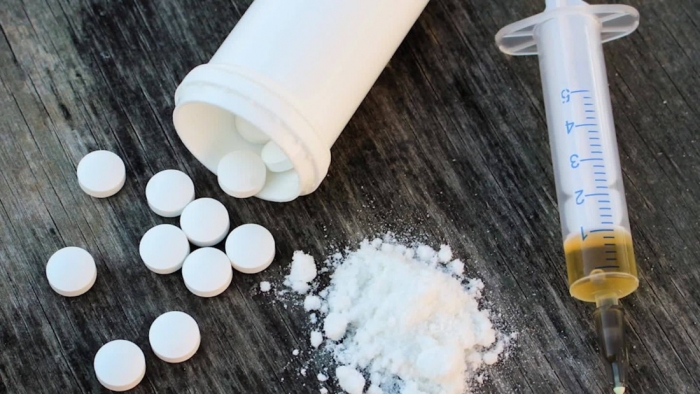Since 2015, the fentanyl crisis has taken Canada by storm: The Public Health Agency of Canada estimated that over 4,000 Canadians lost their lives to opioid-related overdose in 2017. On Jan. 12, Dr. Carole Morissette, Montreal Public Health medical chief, delivered a public health warning to recreational drug users, signalling that the crisis had reached Quebec.
In the face of this newly-arrived public health emergency, Quebec needs to take action now to prevent the situation from taking the same nightmarish toll as in Western Canada. Currently, safe injection sites are not stocked with naloxone, the antidote to counter a fentanyl overdose. Naloxone can temporarily reverse a fentanyl overdose by slowing down the user’s absorption of the opioid by 30 to 60 minutes, allowing time for emergency medical help to arrive. It is the only treatment for an opioid overdose. Support staff at safe injection sites must rely on emergency response teams to provide such medication.
If harm reduction is truly a priority in the Canadian government’s strategy against drug and substance abuse, oversights at the provincial level such as this one are unacceptable. Provincial policy makers must correct any holes in the system that put drug users at risk.
Fentanyl is 50 to 100 times more powerful than other opioids, such as morphine. This places its users at a high risk of an overdose; a dose the size of a grain of sand can be lethal. The lethal opioid is often found laced into other drugs, including counterfeit oxycodone pills and an increasing number of recreational drugs like cocaine, MDMA, and heroin. Consumers of street drugs, whether they are habitual or first-time users, have virtually no way of knowing that fentanyl’s been added: You can’t see it, smell it, or taste it. As the range of drugs that fentanyl contaminates increases, so does the scope of the population at risk of an overdose.
As of November 2017, naloxone is available at 1,900 pharmacies across Quebec to anyone over the age of 14—even without a prescription. As a part of Health Minister Gaétan Barrette and Public Health Minister Lucie Charlebois’s attempts to protect the province against the fentanyl crisis, police, firefighters, and ambulance crew are expected to carry naloxone kits on them at all times. Notably, the general public’s access to naloxone is only a very recent development in the response to the spread of the opioid crisis in Quebec.
Yet, these measures do little to protect those who are most at risk of a fentanyl overdose. More than 75 per cent of Montreal’s drug users regularly frequent community organization-run safe injection sites and needle exchanges to obtain their paraphernalia.
Shockingly, these institutions haven’t benefited from the wide distribution of naloxone kits like Quebec’s pharmacies have, despite Montreal Public Health’s expressed desire to equip any place where drug use might occur. Safe injection sites in British Columbia already benefit from their province’s wider distribution plan; Quebec should follow suit.
By rolling out naloxone in pharmacies and providing emergency response teams with the antidote, the Quebec public health system has merely done the bare minimum in combatting the fentanyl crisis. If drug users are at the same risk of a fatal fentanyl overdose when taking intravenous drugs at a safe injection site as anywhere else, they have less incentive to continue to use those spaces. Safe injection sites betray their primary purpose if they cannot guarantee drug users with protection against the ravages of the opioid crisis. The system is failing these users by cowering behind the pretense that naloxone is widely available to anyone who needs it.
Safe injection sites should be exactly what their name purports—safe. Public health services cannot wait for another onslaught of fatal drug overdoses caused by fentanyl to expand naloxone’s availability to those sites and finally make them safe again.










Portugal is held up as the gold standard for “decriminalizing” drugs and not “judging” the addict. Their programs has some success due to wrap-around services and is mandatory. Portugal does not have a “Safe” Injection Program. Drug dealing is still illegal and dealt with harshly. Other EU countries tried to emulate the program. With the 2008 recession, their budgets were slashed for the addicts in program and caused overdoses, increased crime, and increased disease transmission, increased homelessness. Can you see us having an Injections Site AND wrap-around services? I don’t believe there will be funding for both. Why not use any proposed funding and increase needed detox/rehab facilities and sober living environments along with all the needed physical/mental health and social services. The way I see it, Injections Sites are prolonging the suffering and misery of the addict with the usual end result of death. Which would be more compassionate?
http://www.vancouversun.com/little+evidence+harm+reduction+reduces+harm+more+than+good/8679087/story.html?fref=gc&dti=189308553419
“The four pillar approach only works when each pillar is properly funded. Prevention reduces the flow of people into addiction. Treatment reduces the number of addicts including those living in the DTES. Policing keeps a lid on the open drug dealing and the affects of the associated problems on the community. Only after these three pillars are properly funded can we afford to spend money on Harm Reduction initiatives that do not encourage abstinence. Putting HR first is like running up debt on your credit card and never paying more than your minimum payments.”
http://www.globaldrugpolicy.org/Issues/Vol%201%20Issue%203/A%20Critical%20Evaluation.pdf
THE JOURNAL OF GLOBAL DRUG Policy AND PRACTICE
A Critical Evaluation of the Effects of Safe Injection Facilities
Garth Davies, Simon Fraser University
Conclusion: Taking Causality Seriously
On the subject of the effects of SIFs, the available research is overwhelmingly positive. Evidence can be found in support of SIFs achieving each of the goals listed at the beginning of the evaluation. In terms of our level of confidence in these studies,the assessment offered here is far less sanguine. In truth,none of the impacts attributed to SIFs can be unambiguously verified. As a result of the methodological and analytical problems identified above, all claims remain open to question.
http://www.hc-sc.gc.ca/ahc-asc/pubs/_sites-lieux/insite/index-eng.php
Vancouver’s INSITE service and other Supervised injection sites: What has been learned from research?
Final report of the Expert Advisory Committee
http://www.kiro7.com/news/local/councilwomans-idea-for-seattle-safe-injection-site-locations-belltown-lake-city/466411868
“At the Vancouver site, the manager said since opening in 2003, the overdose death rate in the area around the clinic has dropped 35 percent. But the clinic also estimates 15 to 20 percent of people using the site come from other parts of the country specifically for it.”
http://www.seattletimes.com/seattle-news/health/is-vancouvers-safe-drug-use-site-a-good-model-for-seattle/
“Although research appears to bear that out, many of the studies that attest to Insite’s success are small and limited to the years after the center opened. For instance, a 2011 study published in the journal The Lancet found a 35 percent reduction in overdose deaths in the blocks surrounding Insite, versus 9 percent in the rest of Vancouver.
But that often-cited study looked only at the period two years before and two years after the center opened, not the ensuing decade.”
http://www.seattletimes.com/seattle-news/health/is-vancouvers-safe-drug-use-site-a-good-model-for-seattle/
“Although Insite is paired with a drug-treatment center, called Onsite, Berner and other critics point out that completion rates are low. Of the 6,500 people who visited Insite last year, 464 were referred to Onsite’s detox center. Of those, 252 finished treatment.”
The Vancouver Insite was placed in a crime-ridden, drug-ridden, low-income neighborhood. It only got worse.
http://www.seattletimes.com/seattle-news/health/is-vancouvers-safe-drug-use-site-a-good-model-for-seattle/
“Although the Insite center is a model, the Vancouver neighborhood surrounding it is nothing to emulate, advocates acknowledged.
“If I came from a city like Seattle and I went to that Insite place, it would scare the hell out of me,” Kral said. “I would think, ‘Are we going to create one of those?’ ””
http://news.nationalpost.com/news/vancouvers-gulag-canadas-poorest-neighbourhood-refuses-to-get-better-despite-1m-a-day-in-social-spending
Vancouver’s ‘gulag’: Canada’s poorest neighbourhood refuses to get better despite $1M a day in social spending
What do you think would happen if this was placed in a middle-class neighborhood, or, ANY neighborhood?
https://www.youtube.com/watch?v=audzsuRMWBE&t=586s
https://www.youtube.com/watch?v=wwJkqTZ5H_s
http://news.nationalpost.com/news/canada/brian-hutchinson-thousands-of-used-drug-needles-have-become-the-new-normal-for-vancouver
4/27/2016
Brian Hutchinson: Finding used drug needles in public spaces has become the new normal for Vancouver
http://www.huffingtonpost.ca/mark-hasiuk/insite-vancouver_b_3949237.html
“Ten years later, despite any lofty claims, for most addicts, InSite’s just another place to get high.”
The 100% positive studies on Vancouver’s Insite (Safe Injection Facility) was done “Early last decade, Montaner and Kerr lobbied for an injection site. In 2003, the Chretien Liberals acquiesced, gave the greenlight to B.C.’s Ministry of Health, which, through Vancouver Coastal Health, gave nearly $1.5 million to the BC Centre (that’s Montaner and Kerr, you remember them) to evaluate a three-year injection site trial in Vancouver.
I asked him about the potential conflict of interest (lobbyists conducting research) and he ended the interview with a warning. “If you took that one step further you’d be accusing me of scientific misconduct, which I would take great offense to. And any allegation of that has been generally met with a letter from my lawyer.”
Was I being unfair? InSite is a radical experiment, new to North America and paid for by taxpayers. Kerr and company are obligated to explain their methods and defend their philosophy without issuing veiled threats of legal action.”
In the media, Kerr frequently mentions the “peer review” status of his studies, implying that studies published in medical journals are unassailable. Rubbish. Journals often publish controversial studies to attract readers — publication does not necessarily equal endorsement. The InSite study published in the New England Journal of Medicine, a favourite reference of InSite champions, appeared as a “letter to the editor” sandwiched between a letter about “crush injuries” in earthquakes and another on celiac disease.”
Really? What kind of “science” produces dozens of studies, within the realm of public health, a notoriously volatile research field, with positive outcomes 100 per cent of the time? Those results should raise the eyebrows of any first-year stats student.”
And who’s more likely to be swayed by personal bias? InSite opponents, questioning government-sanctioned hard drug abuse? Or Montaner, Kerr and their handful of acolytes who’ve staked their careers on InSite’s survival? From 2003 to 2011, the BC Centre received $2,610,000 from B.C. taxpayers to “study” InSite. How much money have InSite critics received?”
There has never been an independent analysis of InSite, yet, if you base your knowledge on Vancouver media reports, the case is closed. InSite is a success and should be copied nationwide for the benefit of humanity. Tangential links to declining overdose rates are swallowed whole. Kerr’s claims of reduced “public disorder” in the neighbourhood go unchallenged, despite other mitigating factors such as police activity and community initiative. Journalists note Onsite, the so-called “treatment program” above the injection site, ignoring Onsite’s reputation among neighbourhood residents as a spit-shined flophouse of momentary sobriety.”
http://www.hc-sc.gc.ca/ahc-asc/pubs/_sites-lieux/insite/index-eng.php
Reducing the Transmission of Blood-Borne Viral Infections & Other Injection Related Infections
“Self-reports from users of the INSITE service and from users of SIS services in other countries indicate that needle sharing decreases with increased use of SISs. Mathematical modeling, based on assumptions about baseline rates of needle sharing, the risks of HIV transmission and other variables, generated very wide ranging estimates for the number of HIV cases that might have been prevented. The EAC were not convinced that these assumptions were entirely valid.
SISs do not typically have the capacity to accommodate all, or even most injections that might otherwise take place in public. Several limitations to existing research were identified including:
Caution should be exercised in using mathematical modelling for assessing cost benefit/effectiveness of INSITE, given that:
There was limited local data available regarding baseline frequency of injection, frequency of needle sharing and other key variables used in the analysis;
While some longitudinal studies have been conducted, the results have yet to be published and may never be published given the overlapping design of the cohorts;
No studies have compared INSITE with other methods that might be used to increase referrals to detoxification and treatment services, such as outreach, enhanced needle exchange service, or drug treatment courts.
Some user characteristics relevant to understanding their needs and monitoring change have not been reported including details of baseline treatment histories, frequency of injection and frequency of needle sharing.
User characteristics and reported changes in injection practices are based on self-reports and have not been validated in other ways. More objective evidence of sustained changes in risk behaviours and a comparison or control group study would be needed to confidently state that INSITE and SISs have a significant impact on needle sharing and other risk behaviours outside of the site where the vast majority of drug injections still take place.”
“It has been estimated that injection drug users inject an average six injections a day of cocaine and four injections a day of heroin. The street costs of this use are estimated at around $100 a day or $35,000 a year. Few injection drug users have sufficient income to pay for the habit out through employment. Some, mainly females get this money through prostitution and others through theft, break-ins and auto theft. If the theft is of property rather than cash, it is estimated that they must steal close to $350,000 in property a year to get $35,000 cash. Still others get the money they need by selling drugs.”
http://www.vancouversun.com/little+evidence+harm+reduction+reduces+harm+more+than+good/8679087/story.html?fref=gc&dti=189308553419
“In addition, the federal government’s Advisory Committee on Drug Injection Sites report only five per cent of drug addicts use the injection site, three per cent were referred for treatment and there was no indication the crime rate has decreased, as well as no indication of a decrease in AIDS and hepatitis C since the injection site was opened.”
https://www.scientificamerican.com/article/massive-price-hike-for-lifesaving-opioid-overdose-antidote1/
Massive Price Hike for Lifesaving Opioid Overdose Antidote
Suddenly in demand, naloxone injector goes from $690 to $4,500
Should we follow the money? Who would be profiting bigly from the increased use of naloxone?
https://www.bramptonguardian.com/community-story/7520683-money-and-resources-for-drug-rehabilitation-sorely-needed-in-peel-say-advocates/
“Setting up free injection sites to deal with the recent spate of drug overdoses does not address the root of the opioid problem, says Ted Brown, executive director of Brampton’s Regeneration Outreach Community.
Instead, Queen’s Park and other tiers of governments should consider investing resources and dollars toward rehabilitation programs to help those dealing with addiction and mental health issues, said Brown. ”
http://www.bcmj.org/premise/supervised-injection-sites%E2%80%94-view-law-enforcement
Supervised injection sites—a view from law enforcement
Jamie Graham, former chief of Vancouver Police has outlined the successful model of dealing with an epidemic: Support, mandatory treatment, abstinence, and counseling as all part of the solution. My recover(ed)(ing) addict friends say they would agree.
https://mosaicscience.com/story/iceland-prevent-teen-substance-abuse
Iceland knows how to stop teen substance abuse but the rest of the world isn’t listening
In Iceland, teenage smoking, drinking and drug use have been radically cut in the past 20 years. Emma Young finds out how they did it, and why other countries won’t follow suit.
http://www.vancouversun.com/little+evidence+harm+reduction+reduces+harm+more+than+good/8679087/story.html?fref=gc&dti=189308553419
“The current campaign reports significant reductions in drug overdoses, yet the Government of British Columbia Selected Vital Statistics and Health Status Indicators show that the number of deaths from drug overdose in Vancouver’s Downtown Eastside has increased each year (with one exception) since the site opened in 2003.”
https://www.usatoday.com/story/news/nation-now/2017/05/05/pigeon-nest-needles-highlights-vancouvers-drug-problem/101323878/
Pigeon nest of needles highlights Vancouver’s drug problem
Some graphs about how overdoses in Vancouver, BC have increased:
https://uploads.disquscdn.com/images/4937e3e285c02900541696be294c99859dd986654fc2ea3b3b1f41f673618dc7.png
One more: https://uploads.disquscdn.com/images/d2f8aa542d4033a1f198a3b0e3e802482a4becf1e45b04e77079e989e5c6460a.jpg
The “Safe” Injection Movement is sponsored by the Drug Policy Alliance, an advocacy group that works to decriminalize drugs and is funded largely by billionaire George Soros. The group has pushed, thus far unsuccessfully, for similar legislation in New York, Maryland, Massachusetts and Vermont.
Here’s some examples of their thinking:
http://www.nadcp.org/sites/default/files/2014/NADCP%20Initial%20Response%20to%20DPA%20and%20JPI%20Reports.pdf
http://www.nadcp.org/sites/default/files/nadcp/NADCP%20Response%20to%20DPA%20and%20JPI%20Media%20Attacks%20on%20Drug%20Courts.pdf
SOROS!!!!